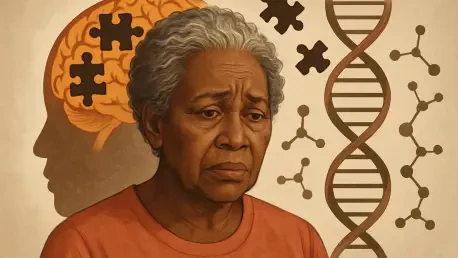In a landscape where Alzheimer’s disease continues to challenge medical researchers and impact millions of lives, a pioneering study has emerged to address a long-standing gap in understanding the disease among African Americans. This demographic, often overlooked in genomic research, faces a prevalence of Alzheimer’s nearly twice as high as those of European descent, a disparity driven by limited healthcare access, testing biases, and higher rates of risk factors like diabetes and cardiovascular issues. This significant research effort, focusing on brain tissue from African American donors, marks a historic step toward uncovering the genetic drivers of Alzheimer’s in this population. By comparing findings with studies of European ancestry, the study not only highlights critical similarities but also reveals unique differences that could reshape therapeutic approaches. The implications of this work promise to advance equity in medical research, ensuring that future treatments are relevant and effective across diverse groups.
Uncovering Genetic Insights in Alzheimer’s Research
A landmark study led by Lindsay A. Farrer, PhD, and a team at Boston University has delved into the genetic underpinnings of Alzheimer’s disease by analyzing brain samples from 207 African American donors, including 125 confirmed cases and 82 healthy controls. Through advanced RNA sequencing, the researchers identified 482 genes with distinct expression levels between the two groups. Among the most striking discoveries was the overexpression of the ADAMTS2 gene in Alzheimer’s patients, with levels 1.52 times higher than in controls. This finding aligns with previous research on European ancestry donors, marking a rare convergence of top genetic targets across populations. Such overlap suggests a shared biological mechanism in Alzheimer’s pathology, positioning ADAMTS2 as a promising candidate for therapeutic intervention. This detailed genetic mapping offers a crucial foundation for understanding how the disease operates at a molecular level in underrepresented groups.
Beyond ADAMTS2, the study pinpointed three additional genes—ITPKB, TDRKH, and LINC0194—that exhibited similar expression differences in both African American and European ancestry cohorts. In total, 65 genes showed common trends across these studies, underscoring both shared and divergent genetic influences on Alzheimer’s risk. While variants like APOE4 are more frequent among African Americans, their association with disease risk appears lower compared to European populations. Even when genes overlap, the specific variants and their impact often vary, highlighting the complexity of genetic contributions to Alzheimer’s. These findings emphasize the importance of tailoring research to capture population-specific factors while identifying universal targets. The potential to inhibit ADAMTS2, linked to reduced levels of the neuroprotective protein reelin, could open new avenues for treatment if proven effective across diverse groups.
Addressing Disparities Through Inclusive Science
The historical underrepresentation of African Americans in Alzheimer’s research has long hindered a comprehensive understanding of disease mechanisms specific to this population, limiting the development of equitable treatments. Despite facing higher rates of Alzheimer’s, systemic barriers such as inadequate healthcare access and biases in diagnostic testing have contributed to this research gap. This study represents a critical shift by prioritizing diversity in genomic analysis, offering insights that could benefit a broader population. By identifying shared genetic targets like ADAMTS2, the research lays the groundwork for therapies that transcend ancestry while acknowledging unique environmental and genetic factors at play. The push for inclusive science is not merely a matter of fairness but a scientific necessity to ensure that advancements in Alzheimer’s care are relevant to all affected communities.
Moreover, the nuanced differences in genetic risk factors revealed by this study underscore the need for continued investment in diverse research cohorts. For instance, understanding why certain genetic variants carry varying risks across populations could lead to more personalized medical approaches. The consensus among experts is that only through such inclusive efforts can the full spectrum of Alzheimer’s drivers—both universal and population-specific—be uncovered. This research also sheds light on the interplay between genetic predisposition and external factors like socioeconomic conditions, which disproportionately affect African American communities. As a result, the findings advocate for a dual focus on biological and social determinants of health, pushing the boundaries of how Alzheimer’s is studied and treated in modern medicine.
Paving the Way for Future Therapeutic Breakthroughs
Reflecting on this groundbreaking research, it becomes evident that the identification of key genes like ADAMTS2 marks a turning point in Alzheimer’s studies among African Americans. The consistent patterns observed across different ancestries provide a rare glimpse into shared disease mechanisms, while the unique genetic variations highlight the complexity of risk factors. This dual perspective is instrumental in challenging the status quo of underrepresentation in medical research, ensuring that the voices of diverse populations are finally heard in the scientific community. The meticulous analysis of brain tissue samples offers a robust dataset that future studies can build upon, setting a precedent for how inclusivity can drive innovation in understanding neurodegenerative diseases.
Looking ahead, the next steps involve rigorous testing of potential treatments targeting genes like ADAMTS2 to determine their efficacy across diverse groups. Researchers aim to explore how inhibiting such genes might mitigate Alzheimer’s progression, particularly by addressing related factors like tau phosphorylation and amyloid plaque formation. Collaborative efforts are also needed to expand sample sizes and include other underrepresented populations, ensuring a more comprehensive view of genetic influences. Funding and policy support for inclusive research initiatives stand as critical components to sustain this momentum. Ultimately, the path forward requires a commitment to equity in science, guaranteeing that the benefits of Alzheimer’s advancements reach every corner of society with tailored and effective solutions.









